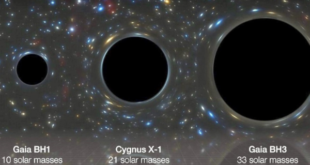Thanks to amazing scientific advancements like NASA’s Kepler Space Telescope and Transiting Exoplanet Survey Satellite (TESS), we have confirmed the existence of thousands of exoplanets. Most of these alien worlds are obscured by the light from their stars, limiting what we can learn about them. For the first time, scientists have managed to detect and analyze the elemental isotopes in an exoplanet’s atmosphere. The team says this could lead to new and better ways of understanding planetary formation.
The planet in question has a real banger of a name, like most exoplanets. It’s called TYC 8998-760-1 b. Catchy, right? Unlike most exoplanets, this planet is actually visible from Earth. It’s 300 light-years away, but it’s not the distance that makes exoplanets hard to spot — it’s the brightness of their host stars. TYC 8998-760-1 b is something of a perfect storm for visibility. It’s enormous with about twice the diameter of Jupiter and 14 times its mass, and the planet orbits its star at a great distance. You can see a real photo of TYC 8998-760-1 b along with its “c” companion planet below.
The new study, led by Yapeng Zhang of Leiden University in the Netherlands, leveraged the visibility of this planet to learn about its composition. The team used the European Southern Observatory’s Very Large Telescope in Chile — specifically, an instrument on the VLT called the Spectrograph for Integral Field Observations in the Near Infrared (SINFONI). As a spectrograph (aka a spectrometer), its job is to measure the properties of light. Because TYC 8998-760-1 b is so large and isolated, it reflects a lot of visible starlight — that’s why we can see it. By scanning the exoplanet to see what bits of the optical spectrum are being absorbed, we can determine what’s out there.
This image, captured by the SPHERE instrument on ESO’s Very Large Telescope, shows the star TYC 8998-760-1 accompanied by two giant exoplanets indicated by arrows, TYC 8998-760-1b (bottom) and TYC 8998-760-1c (top).
According to the researchers, TYC 8998-760-1 b has large deposits of carbon-13, a version of the ubiquitous element with seven neutrons instead of six. The team found about twice as much carbon-13 as you’d normally expect. Those extra neutrons actually tell us something important. TYC 8998-760-1 b is so frigid that it freezes carbon monoxide, and it’s probably always been like that. To have this much carbon-13 in the CO ice, the planet must have formed near its current orbit. It was not closer to the star like all the planets in our solar system are.
This is important data because our solar system is the only one we’ve been able to study up close. Detecting isotopes on exoplanets can therefore offer a window into their formation, which may be entirely different than what happened here.
Now read:
Subscribe Today to get the latest ExtremeTech news delivered right to your inbox.
© 1996-2021 Ziff Davis, LLC. PCMag Digital Group
ExtremeTech is among the federally registered trademarks of
Ziff Davis, LLC and may not be used by third parties without explicit permission.
We strongly encourage you to read our updated PRIVACY POLICY and COOKIE POLICY.
Tags detect exoplanet first isotopes scientists
Check Also
Samsung to Receive $6.4 Billion in CHIPS Act Funding
Samsung has now joined Intel and TSMC in receiving billions in US government subsidies to …
 #Bizwhiznetwork.com Innovation ΛI |Technology News
#Bizwhiznetwork.com Innovation ΛI |Technology News



